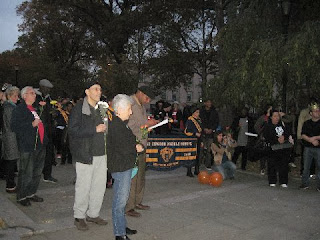We thought the Post was always ridiculous but this one takes it to bizarroland. Which of these assertions on the Richard (Idiot) Johnson piece are false?
1. De Blasio really wants Randi for Chancellor.
2. Randi really wants the job.
3. Randi "is against charter schools, teacher evaluations and most of
the other reforms Mayor Bloomberg enacted.
Answer: While we can't vouch for 1 and 2, we can guarantee that 3 is absolutely false: The UFT has 2 charter schools started by Randi, supports teacher evaluations and common core and indeed has backed many of the Bloomberg deforms.
Randi is so extremely unpopular with NYC teachers she might get lower ratings than Joel Klein. Just check today's doings over at the Ravitch blog (
Mercedes Schneider Emails Randi Weingarten). Last I read, only Leo Casey and Peter Goodman were defending her -- though I imagine they'll drag out some Unity slugs to join in even though we saw in the last election that even Unity slugs were not willing to defend Randi.
Would Randi give up double the salary she gets as AFT president and the national presence to even consider being NYC Chancellor? Impossible. Thus we are left with the question as to whether this came from the De Blasio people. Is he so clueless? I doubt it. Or certainly hope not. So what this is is a last ditch effort by the Post to deflect some last minute votes away from de Blasio.
But this has to be the funniest part of the Richard Johnson piece of fiction (sorry Richard, you don't meet common core standards as fiction is taboo).
“The idea of putting a union chief in charge of a school system is
mind-boggling,” said a political consultant. “It strains credulity that
de Blasio would go that far.
Some union chief. What would strain credibility would be de Blasio actually being serious.
http://pagesix.com/2013/11/04/de-blasio-studying-up-on-weingarten-for-schools-chancellor/
Richard Johnson
November 4, 2013 | 8:04pm
Bill de Blasio is considering hiring teachers’ union boss Randi Weingarten as the next NYC schools chancellor, sources tell me.
Weingarten — who was head of the United Federation of Teachers in New
York before becoming chief of the national American Federation of
Teachers — is against charter schools, teacher evaluations and most of
the other reforms Mayor Bloomberg enacted.
“She wants the job, and de Blasio’s people have been making calls,
asking about Weingarten and testing the reaction,” said one well-placed
source in the public education sector.
“The idea of putting a union chief in charge of a school system is
mind-boggling,” said a political consultant. “It strains credulity that
de Blasio would go that far.”





 Students at Stuyvesant high school became the latest to boycott the new tests from the evaluation system.
Students at Stuyvesant high school became the latest to boycott the new tests from the evaluation system.



























